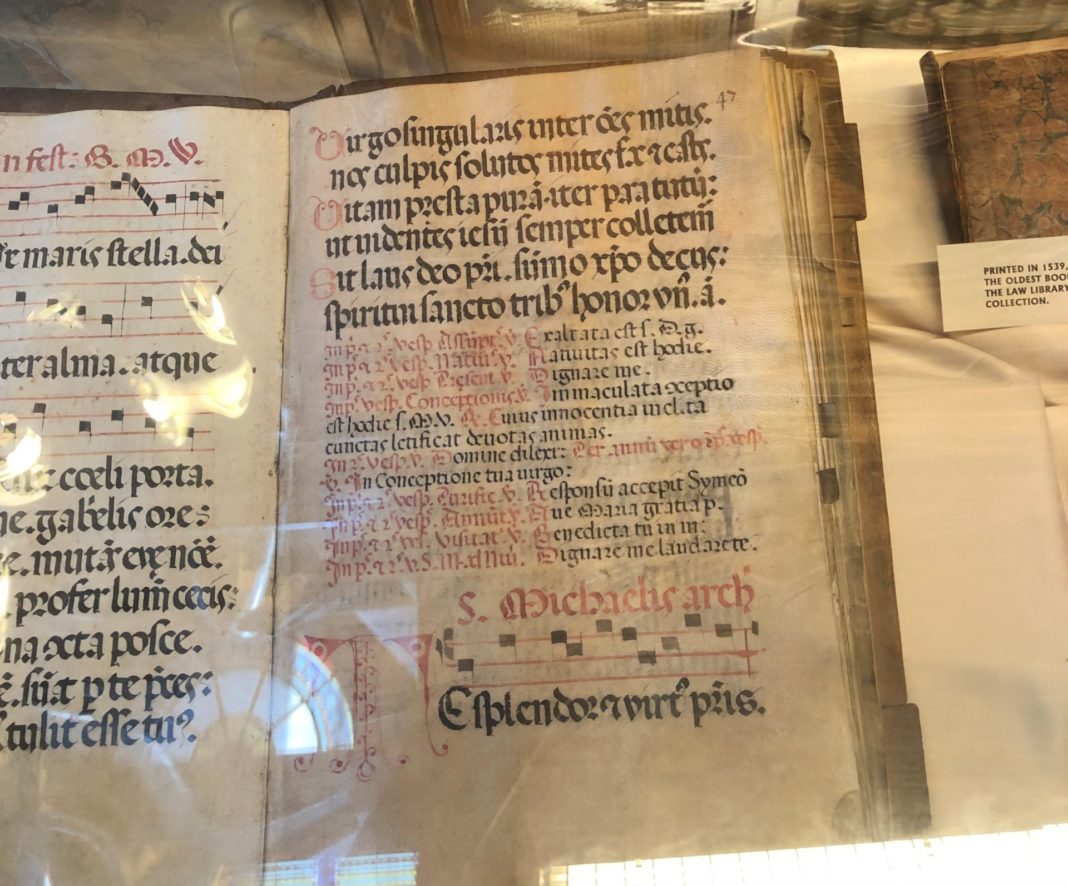In our post-Covid era in the Iowa Legislature, many Committee meetings, always open to the public, are being held this year in the beautiful Capitol Law Library!
As attendees walk into this neo-hearing room, each one filed past the under-glass display case of the Rare Book Collection. Today I would like to single out the largest of said books—the only one opened on the spine, displaying both a left and right page of the book for viewing.
The book in question is from the 1300s—purchased in Florence, Italy in 1921, and later sold to the State of Iowa.
According to Canon Lawyer and Latinologist The Rev. Michael F. Gutgsell, JCL, past Chancellor and Moderator of the Curia for the Archdiocese of Omaha:
“This is a choir book ( I am guessing that this is larger than a hand-sized book) which was probably used by more than one or two monks.”
Gutgsell describes: “The very top of the left-hand side of the book, in red, indicates that this musical piece honors Blessed Mary, Virgin. The illustrated depiction to the left side shows a monk venerating Mary holding Jesus (could be St. Francis of Assisi, note the cowl (or hoodie) of the monk?).”
Elaborating further, our canonist/Latinologist explains: “The Mid-ages manuscripts use a kind of shorthand throughout the text (for instance, the red script looks like ‘In felt, BMV’ but the ‘In‘ letters are instructions as to how to sing the following piece, and the ‘f’, in felt, is actually an ‘s’.
So, we have here a hymn used to open Vespers (Evening Prayer). I have clipped the complete text in latin and its translation (from the amazingly accurate Wikipedia entry):
“Authorship of the original hymn has been attributed to several people, including Bernard of Clairvaux (12th century), Saint Venantius Fortunatus (6th century)[1] and Hermannus Contractus (11th century).[2] The text is not found written by 9th-century hands, but as a tenth-century addition in two 9th-century manuscripts, one from Salzburg now in Vienna[3] and the other still at the Abbey of Saint Gall.[4] Its frequent occurrence in the Divine Office made it popular in the Middle Ages, many other hymns being founded upon it.[1] The ‘Ave maris stella’ was highly influential in presenting Mary as a merciful and loving Mother.[5] ‘Much of its charm is due to its simplicity’ .[6] The title, ‘Star of the Sea’ is one of the oldest and most widespread titles applied to Mary. The hymn is frequently used as a prayer for safe-conduct for travelers.[7]
The melody is found in the Irish plainsong ‘Gabhaim Molta Bríde’, a piece in praise of St. Brigid of Kildaire.[8] The popular modern hymn Hail Queen of Heaven, the Ocean Star, is loosely based on this plainsong original.
Latin lyrics[edit]
Beginning of Ave Maris Stella, in its ancient chant setting
The Latin text of the hymn as authorized for use in the Liturgy of the Hours of the Roman Rite (ordinary form) is the following:[9]
| Ave, maris stella,
Dei mater alma, atque semper virgo, felix cœli porta.
Sumens illud «Ave» Gabrielis ore, funda nos in pace, mutans Evæ[10] nomen.
Solve vincla reis, profer lumen cæcis, mala nostra pelle, bona cuncta posce.
Monstra te esse matrem, sumat per te precem [11] qui pro nobis natus tulit esse tuus.
Virgo singularis, inter omnes mitis, nos culpis solutos mites fac et castos.
Vitam præsta puram, iter para tutum, ut videntes Jesum semper collætemur.
Sit laus Deo Patri, summo Christo decus, Spiritui Sancto tribus honor unus. Amen.[12] |
Hail, star of the sea,
Nurturing Mother of God,And ever Virgin Happy gate of Heaven
Receiving that “Ave” (hail) From the mouth of Gabriel, Establish us in peace, Transforming the name of “Eva” (Eve).[13]
Loosen the chains of the guilty, Send forth light to the blind, Our evil do thou dispel, Entreat (for us) all good things.
Show thyself to be a Mother: Through thee may he receive prayer Who, being born for us, Undertook to be thine own.
O unique Virgin, Meek above all others, Make us, set free from (our) sins, Meek and chaste.
Bestow a pure life, Prepare a safe way: That seeing Jesus, We may ever rejoice.
Praise be to God the Father, To the Most High Christ (be) glory, To the Holy Spirit (Be) honour, to the Three equally. Amen |
End Wikipedia entry.
Father Gutgsell continues:
“The smaller print at the end of the musical notes is quiet hard for me to make out. The rule in Latin text is that “red” are rubrics or directions, and “black” is text to be said or sung as prayer or additional text which follows the hymn.”
“At the very bottom of the right side page are ‘red’ letters containing the words ‘Saint Michael, Archangel.’ I cannot decipher the first ‘black’ word because of the highly stylized calligraphy, but the second and third words are ‘viri piis,’ or pius men in the fist person plural, but we would have to know the words (no doubt on the next page) to make sense of these three words. It seems that Michael is being invoked in some way or another.”
Gutgsell concludes: “I hope that this gives you some better grasp on these two pages. Such books were not only practical in that they present prayers to be sung but they also are beautiful to behold (which likely to have been made so as a way to lift up and compliment the beauty of singing the hymn).”












